The Miracle of Zakouma & the Energy of the Ennedi
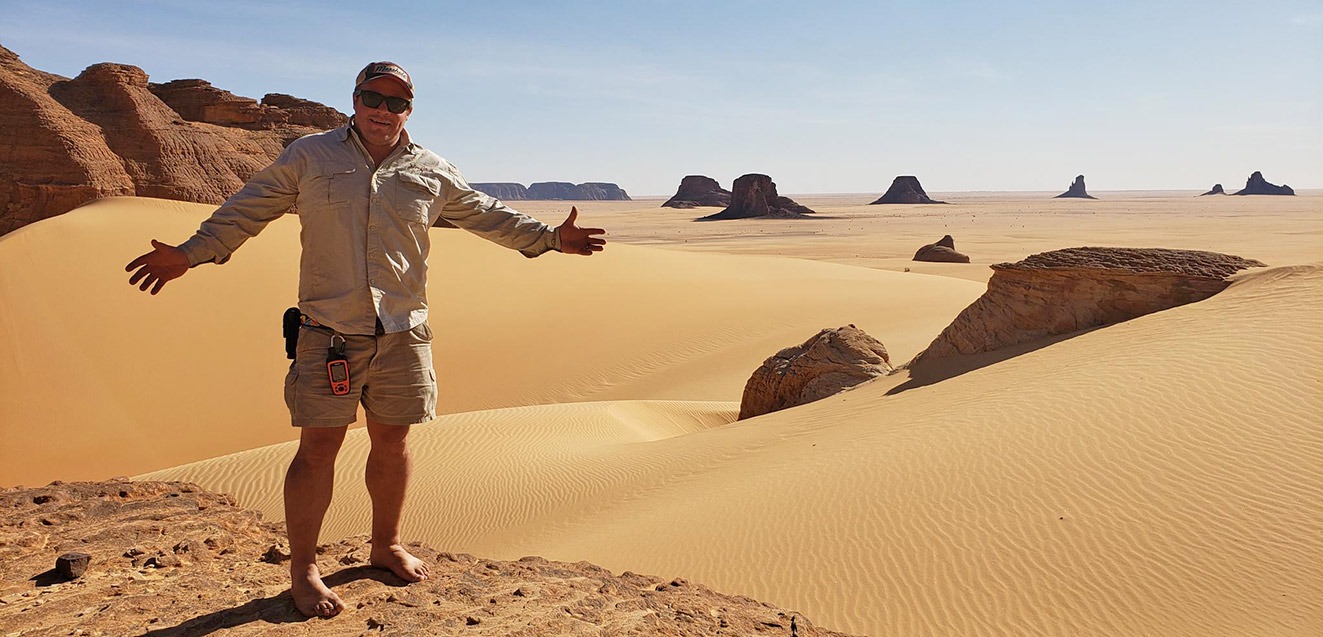
To make a long story short, over the past 20 years I have had the good fortune to travel with my childhood hero and good friend Kingsley Holgate. Just to give you a quick background, Kingsley Holgate is a modern-day explorer and regarded as Africa’s most traveled man. His explorations are often “world’s first” expeditions. I am a private guide who has had the good fortune to guide in many wonderful destinations all over the African continent. In addition, I have been a team member of Kingsley’s expeditions for the past 20 years.
For years and years, at countless campfires, we would sit and discuss far-off places and cultures that captivated our imaginations, places we just had to find a way to see. There were many places on the list, but two hard-to-reach areas kept making it into the fireside conversations.
Zakouma National Park was always high up on the list of places that we would discuss and dream of, but how would we get there? And surely, once you’ve made the huge effort to get there, you would have to make the push to also see another one of those places. After all, you are in Chad—when will you be there again? You just have to go for it—the Ennedi Massif in the northeast of Chad. Now I have to be honest, I had heard so much about Zakouma and the wonderful revival of a near defunct park from my friend Riaan Labuschagne, who at the time was the head of the park. Zakouma was rescued just in time by African Parks to become the miracle that it is today, but the Ennedi was completely unknown to me. I couldn’t be more naïve about the place—after all, my focus has always been wildlife and culture—so what on earth did the Sahara have to offer for me?
Then came the opportunity. Thanks to the brilliant and creative minds of the travel specialists at GeoEx, a trip to Chad was born. Kingsley and I were the lucky ones to lead this exploratory trip and because I am not a great writer, and even the words of great writers would not do these areas any justice, I am rather going to show some pictures with brief descriptions! Hopefully you will read this and find your own inspiration to visit these places with Kingsley and me as we make our return in March of 2022.
Chad is the sort of destination that governments give travel warnings against and skeptical friends say, “You wanna go WHERE?” In short, and in the interests of getting to the good bits, I will spare you the details of the trip to the central market and the artisanal market in the capital. Essentially you fly into and out of the capital, N’Djamena, with a charter flight from there to both Zakouma and the Ennedi. It’s all easy, comfortable, and safe!
Zakouma National Park
Zakouma means “place of abundance” and boy oh boy does it live up to its name! Who would have thought that north of the Nile and just a little south of the Sahara you would find an ecosystem that’s best compared to Botswana’s Okavango Delta? Unbelievably, this area is waterlogged and inaccessible for much of the year. Zakouma is only really doable in the months from January to the end of April, and the space at Camp Nomade is divided into weekly slots for private groups of just 8 at a time. So, when you consider there are really only about 15 weeks to visit with 8 guests per week, it’s pretty exceptional to be one of the 120-odd visitors per year and it’s safe to say that “place of abundance” does not refer to tourists!
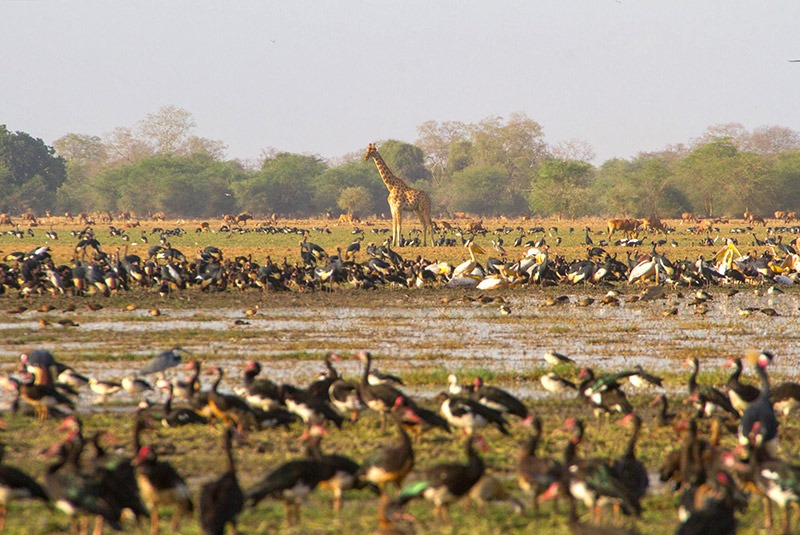
This is one of the most inspirational conservation success stories to come out of Africa, thanks to political will from the Chadian Government and the dedicated conservationists at African Parks. Zakouma’s elephants were decimated by Janjaweed rebels (“devils on horseback”) from Darfur in Sudan, but thanks to diligent management, crucial donor money, and no-nonsense anti-poaching measures in place at the park, the first elephant calves in over a decade are being born again and the park is flourishing.

It’s fiercely hot and the animals can’t resist the last of the drying pools of water, just a stone’s throw away from our camp. As I look out from the canvas of my tent, I see hundreds of tiang, a lone roan antelope bull, Buffon’s kob, endangered Kordofan giraffe, Lelwel’s hartebeest, Defassa waterbuck, and, against the tree-line, what must be well over a thousand richly colored Central African Savannah buffalo and lions. There are always lions. We hear them and see them around camp day and night, as they simply can’t resist the abundance of prey. Kingsley remarks, “I have travelled to the far corners of Africa, but I’ve never seen anything like this before, it really is something out of ‘Old Africa.’”
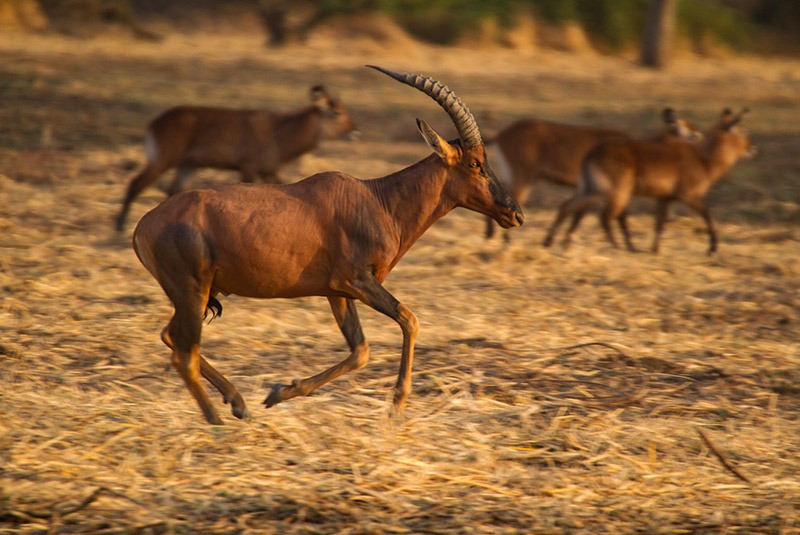
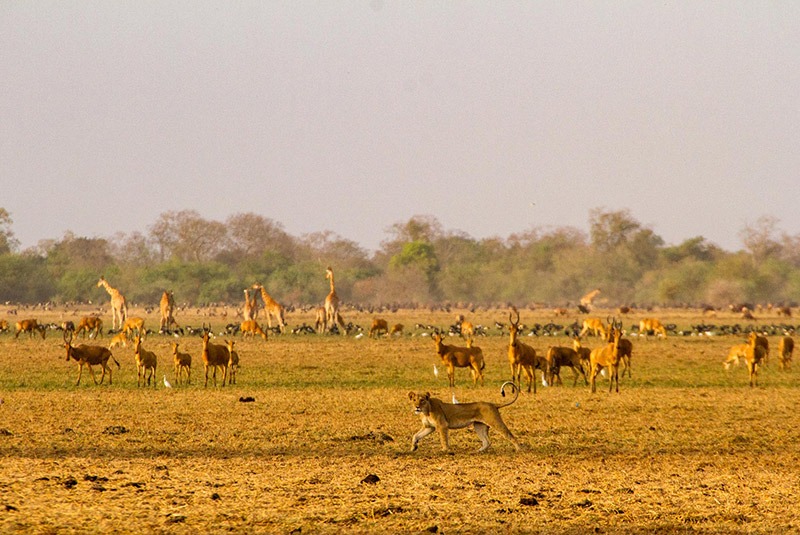
I am stunned by the birds: this is the greatest bird show on the planet. The list is beyond impressive and I am in my element, with a very sore neck, trying to add to my list. If you are not completely blown away, awestruck, and left speechless by the absolutely incredible sight of birds of prey dive bombing into the charcoal-colored clouds of millions upon millions of red-billed quelea—then I am not sure we will be able to enjoy a cold one together! This happens every morning and every evening, right in front of our camp. Tree branches fall from the sheer weight of roosting quelea, and the sound of millions of wings flapping in perfect union is worth every mile traveled to reach this point.
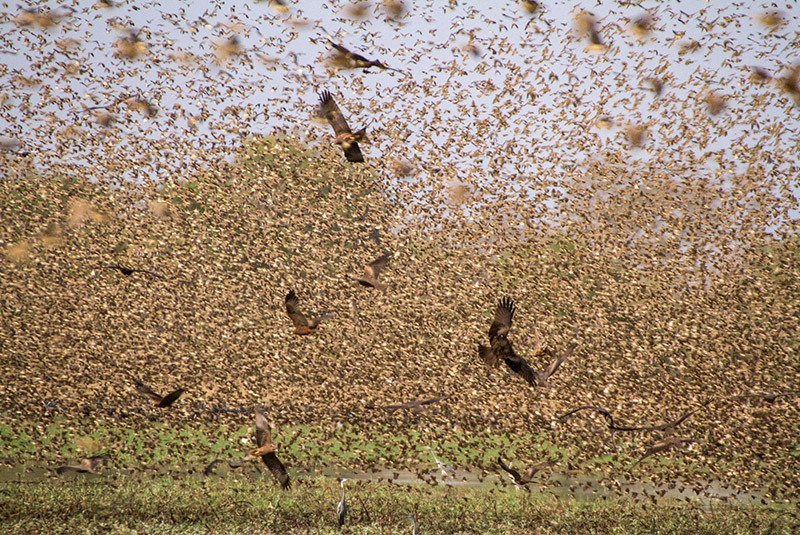
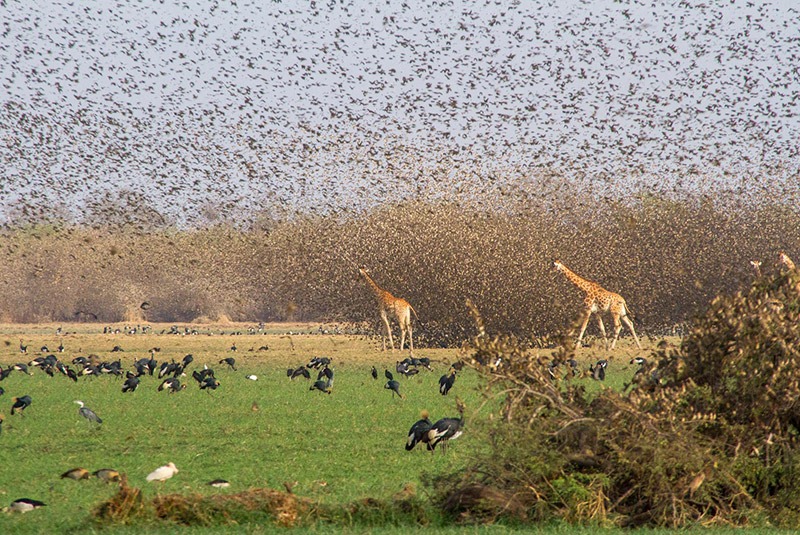
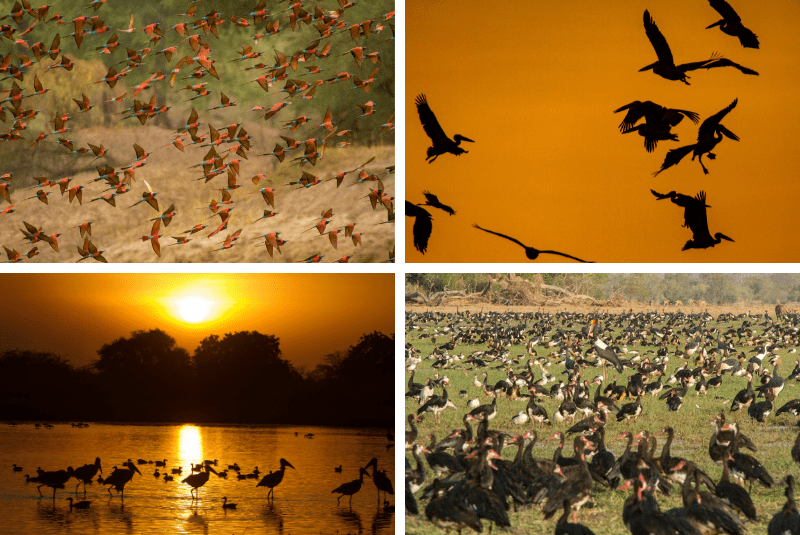
Each day here has a really unique element, and it’s not just day and night game drives or game walks, which are very exciting in their own right and rival any safari destination. African Parks are delighted to have us here and take great pride in showing us their control room and armory. We learn a great deal about what it takes to manage this place—protecting not only the ecosystem but also the surrounding communities. Whilst I would love to show you images from our visit to these facilities, I am reminded that there is sensitive information, and no chances are taken. We are asked not to share these photographs. The head of the operation goes on to gives us GPS coordinates to find the aptly named, heavily armed, and well-trained Mamba Anti-Poaching Unit. We head out for a two-night fly camping expedition along the Salamat River in order to locate the team, who will guide us in to see the 500-strong mega herd of elephant now in the south of the park.
The Mamba team’s camp moves daily as they follow the mega herd. It’s a simple affair and a massive commitment: a small fire with blackened kettle and enamel mugs for sweet black tea, a grass sleeping mat for each ranger. These guys mean business and are heroes. We don’t forget their incredible sacrifices, which make this place safe for wildlife and people alike. There is a somber reminder of this on the walls of the control room, where 13 framed photographs are mounted: one for each fallen Zakouma ranger who has been killed by the Janjaweed rebel poachers.
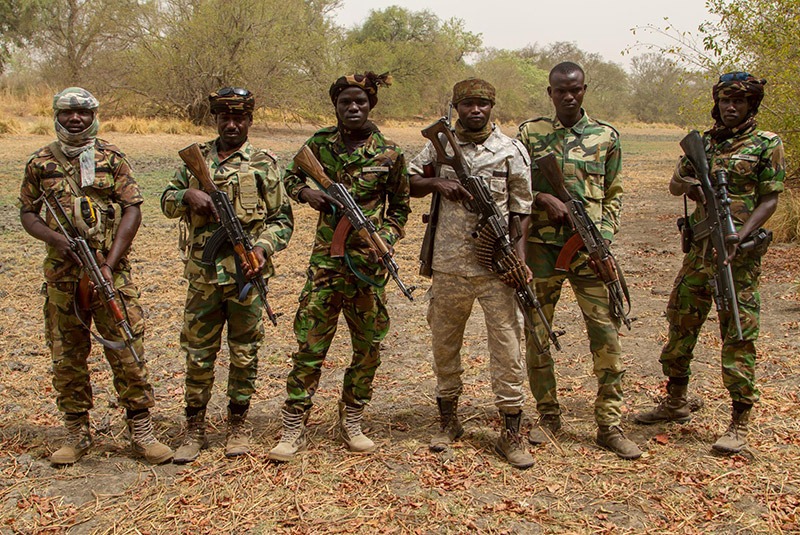
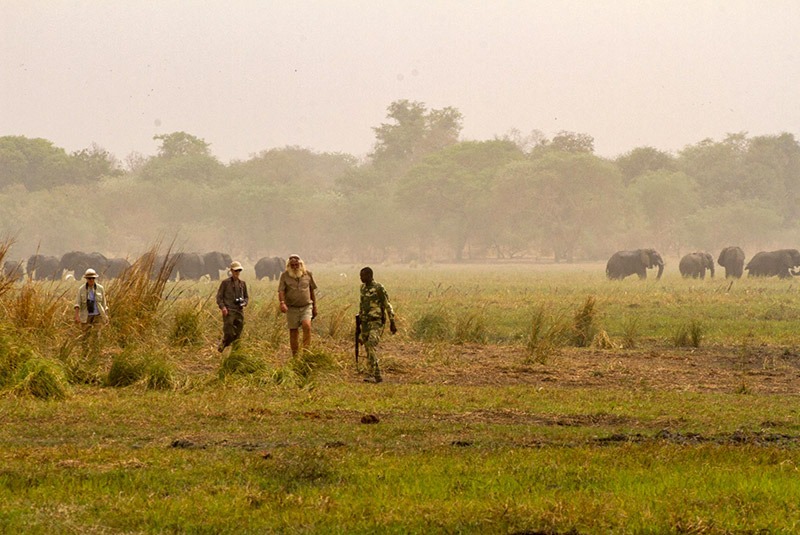
As we find ourselves back in the familiar setup of our nomad-inspired base camp, having successfully tracked the elephants, I reflect on all that we have seen on this trip. There is so much to say about this place, but what really took me by surprise is the number of firsts. There were just so many things that I have never seen before—and if I had seen them before I had never seen them in that kind of concentration. Zakouma is truly remarkable and we are not done yet!
We still have a visit to a Saturday market called Kach Kacha outside the park, where we are transported back in time with visions of the trade in gum arabic, colorful textiles, camels, goats, horses, blacksmiths using traditional methods to forge beautiful Arabic knifes—it’s all an assault to the senses. On our way back to camp we visit a local school on the park boundary and immerse ourselves in an elephant education program with the kids. This has been a passion project of Kingsley’s for the past 10 years, which has taken the conservation message to hundreds of thousands of kids all over the continent.
Here are a few scenes from the Kach Kacha market and elephant education at the local school in the nomad village of Goz Djarat . . .
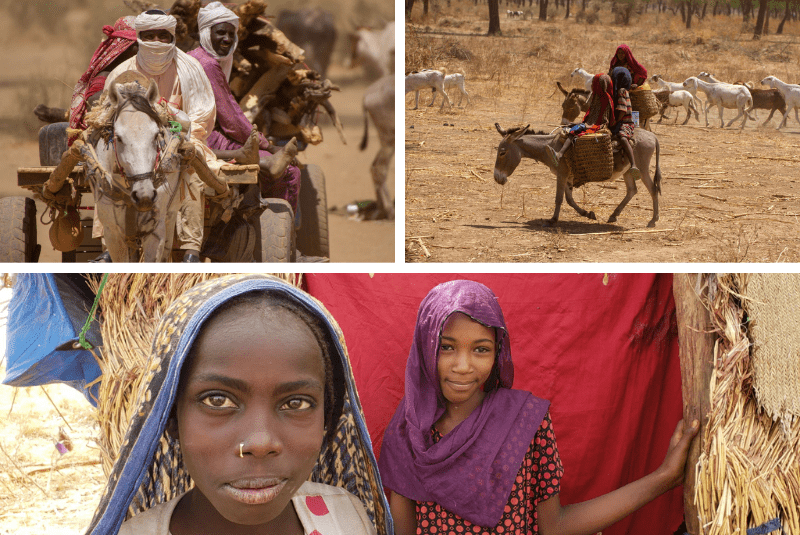
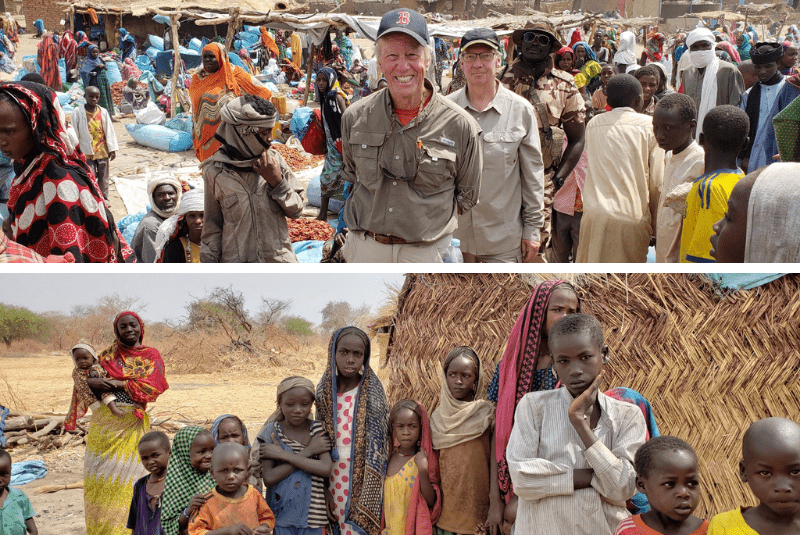
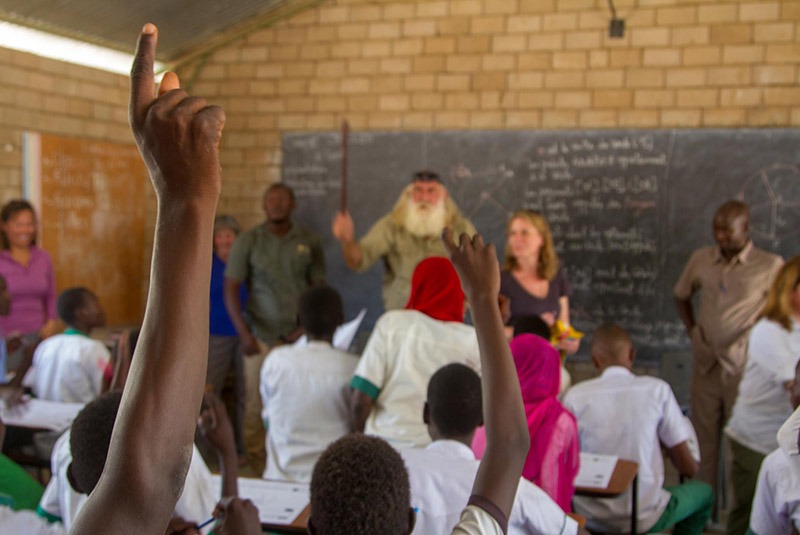
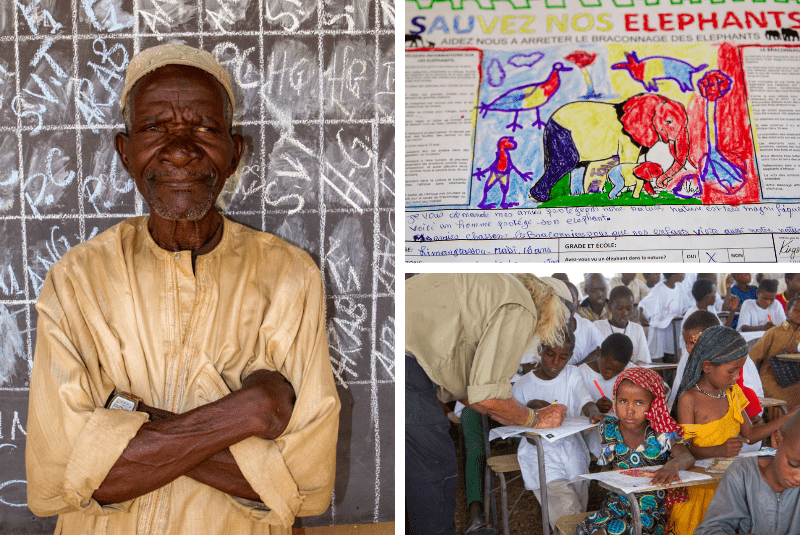
It’s not an easy safari here in Zakouma but I have loved it and would not change a thing! I don’t want to see a fan in the simple tent setup, I like the bucket shower and loo with a view. If it means I have to sweat a little to stay in “Old Africa” then so be it. While properties across Africa work tirelessly to reach new standards and up the “cotton count,” they are systematically taking the wild edge out of Africa. There is a place for everything of course, but this is a place for raw Africa!
* * * * *
I have a strange feeling today—there is something I am not so sure about. I haven’t spent much time in deserts, and while they really do intrigue me, I just can’t imagine how you could fill 10 days. I am nervous because I am used to having wildlife and interesting landscapes as a canvas when I guide guests. I ask myself, “What is this going to entail and what will I talk about?” I will be out of my element from here on in, but I don’t remember seeing Kingsley as excited to see a new place as he is right now, and that single fact relaxes me completely! I have followed Kingsley to the Southern, Western, Northern, and Eastern most points of Africa—not to mention the world’s first expedition to find the geographic center point of the continent, deep inside the Congo rainforest. I have learnt to trust Kingsley’s judgement and if he is this excited, then I am excited too. One thing is certain—it’s a mysterious place and nobody really knows what to expect!
We fly north on our small charter plane, far north, all the way to the border with Libya. We have Pier Paulo Rossi on the flight with us. He is a delightful Italian gentleman, a friend, and a rock art specialist. He first fell in love with the Sahara in 1987 whilst working in Agadez and Niger. Now he is a true son of the desert and we couldn’t have a better man to lead us north.
Ennedi Massif
The adventure begins to unfold as we land on a dry salt pan with a lineup of land cruisers, our “ships of the desert” for the next 10 days. We have finally arrived, and I can see why they call the Ennedi the Jewel of the Sahara. It’s quite something to find oneself in one of the most beautiful parts of the nine-million-square-kilometer Sahara—the largest desert on Earth—and I am knocked out by its natural beauty.
Our beautiful, white-tented camp at Warda is surrounded by a sandstone museum of rock art.
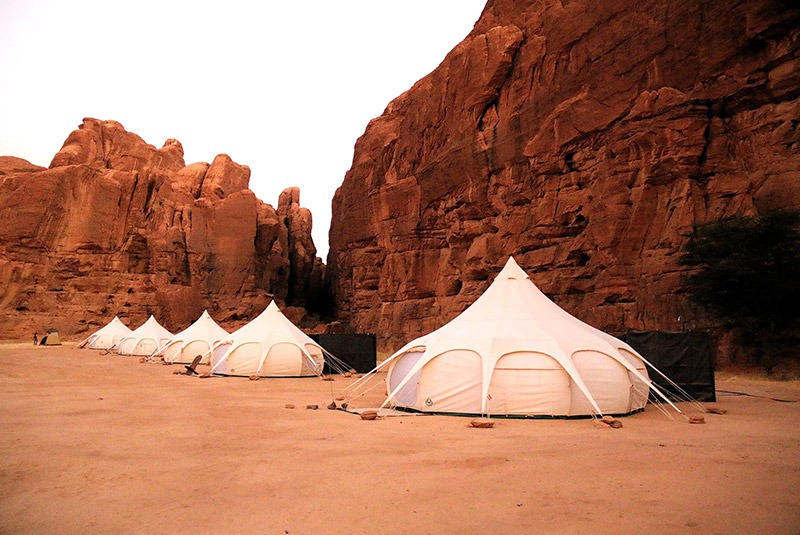
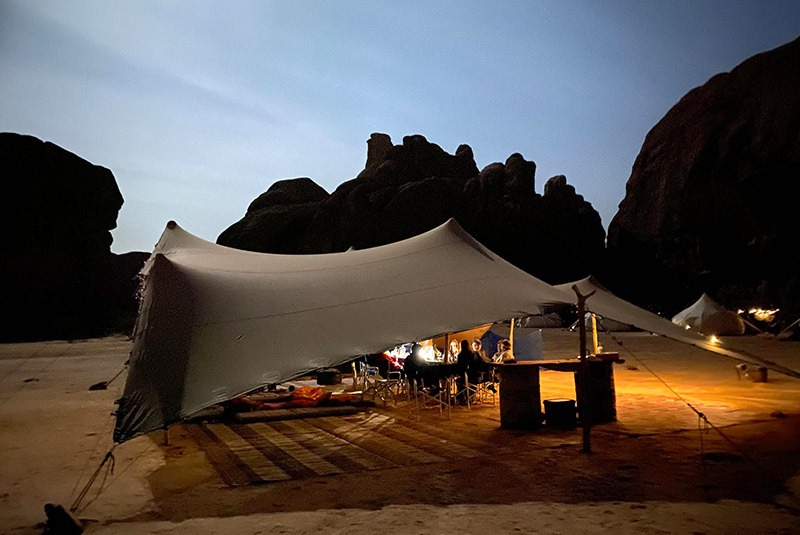
It’s truly otherworldly, as we make our way by cruiser and partly on foot to the Arch of Aloba, a Bidiyat (local tribe) word, which means “a sacred place.” Aloba is 262 ft wide by 420 ft high, second only to Shipton’s Arch in China. It’s an incredible area of the great Sahara, tortured by millions of years of heat, wind and time, weathering and time, erosion and time, time, time. . . . This is a place so ancient and different that no words can explain the crazy, multi-colored sandstone formations that are such a part of the Ennedi Massif. I struggle to comprehend that we have ALL of this to ourselves.
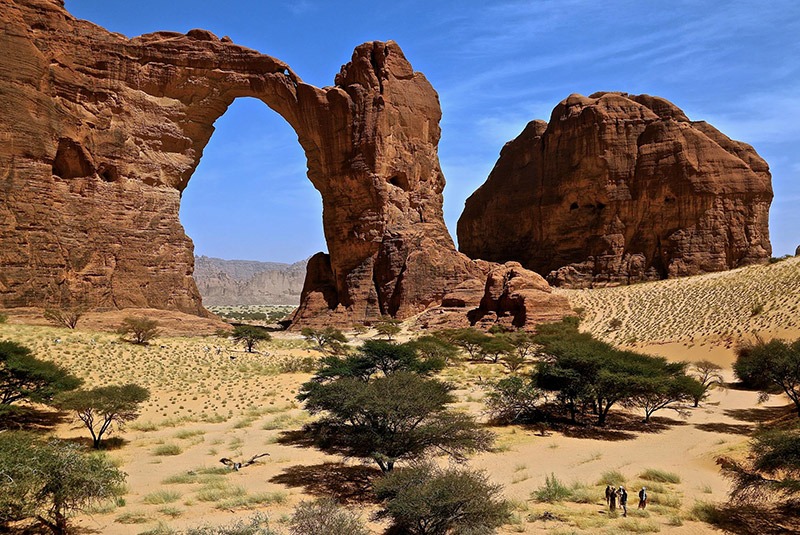
From the shade of an acacia tree, we take lunch. Maybe it was the desert heat or the magnificent solitude of it all that inspired us to take turns coming up with some crazy off-the-wall descriptions of what lay ahead of us. Pat, who at 88 still packs his own parachute, said, “Look at these out-of-control chess pieces, or are they fallen dominoes?” And in Creig’s words, “Was this a Druid architect’s studio commissioned to build a Stonehenge?” Diane thought it was “Wadi Rum on steroids.” Truth is, we are all lost for words—there is every sandstone rock shape imaginable: mushrooms and shillelaghs, crocodiles and turtles, citadels, dynasties of dinosaurs, jumbles of juggernauts. There are bottle shapes, wine glasses, calabashes, bowling pins (thanks Shelly), champagne flutes, and dragons.
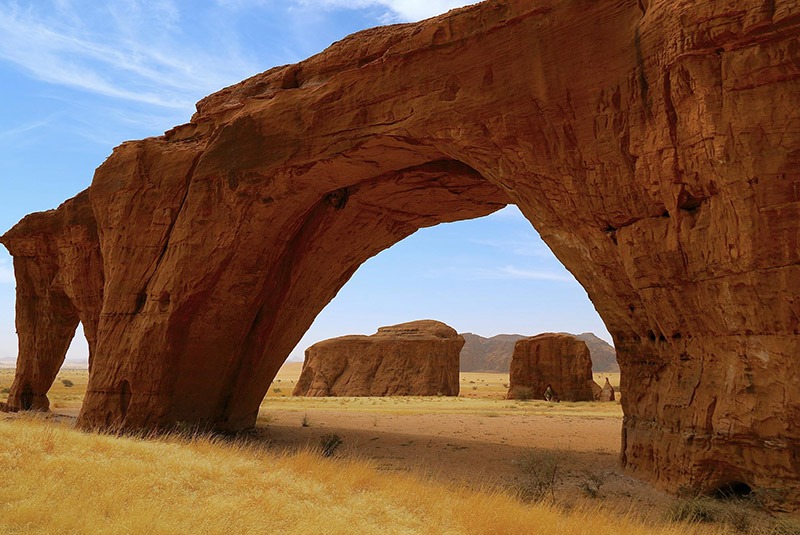
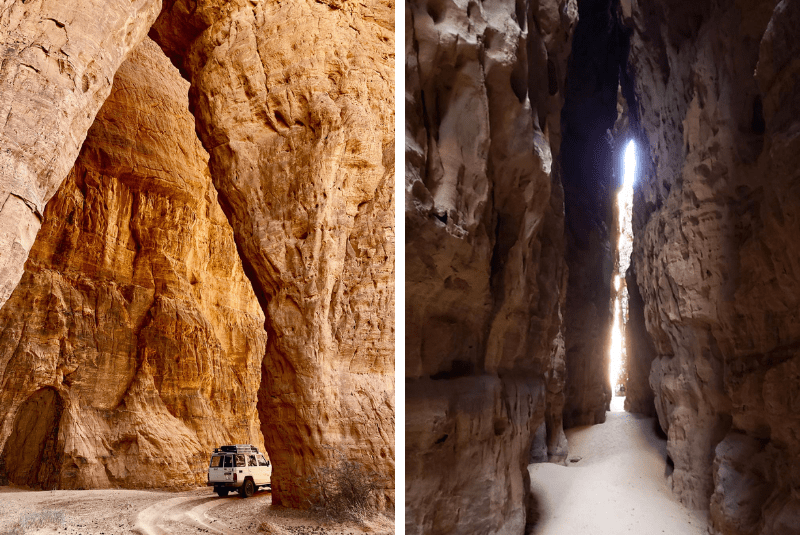
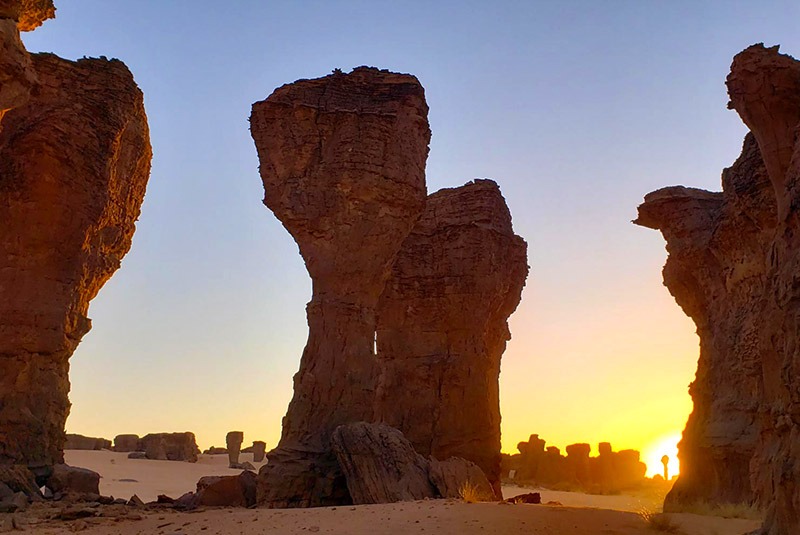
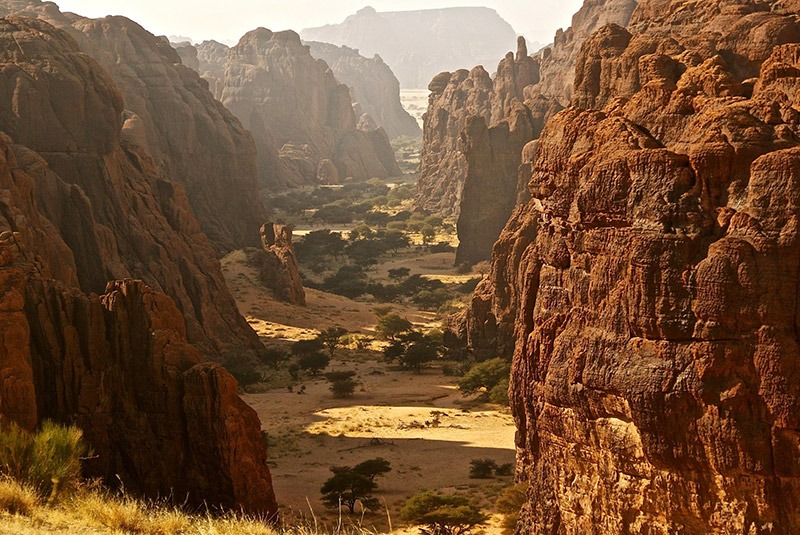
A plethora of organ pipes to fill 1000 cathedrals, poking into the perfect blue sky! This is the Ennedi, a far cry from the endless dunes of storybook Sahara, and from anything that I could ever have imagined. It’s taken me a couple days, but I have realized the best way to guide in this part of the world is to sit back and let the place do the talking. There is no need to make noise for the sake of noise, and my attention is turned to making sure everyone is comfortable and able to get the most out of the opportunity!
There were so many highlights over the days and not a single day was like another. Clambering over the rocks with gentle help from Fati. The daughter of the local Tubu chief, who waltzed over the rocks wearing a black head scarf, blue sequin dress and flip-flops, carrying a small stick and water bottle as she led us up a steep goat track through the rocks. These are the Tubu people of the Archei clan and this is their home. The view from the top is biblical as we get our first look at the Guelta d’Archei. Later we take a walk down through the Guelta amongst the grunting, gurgling, thirst-quenched camels.
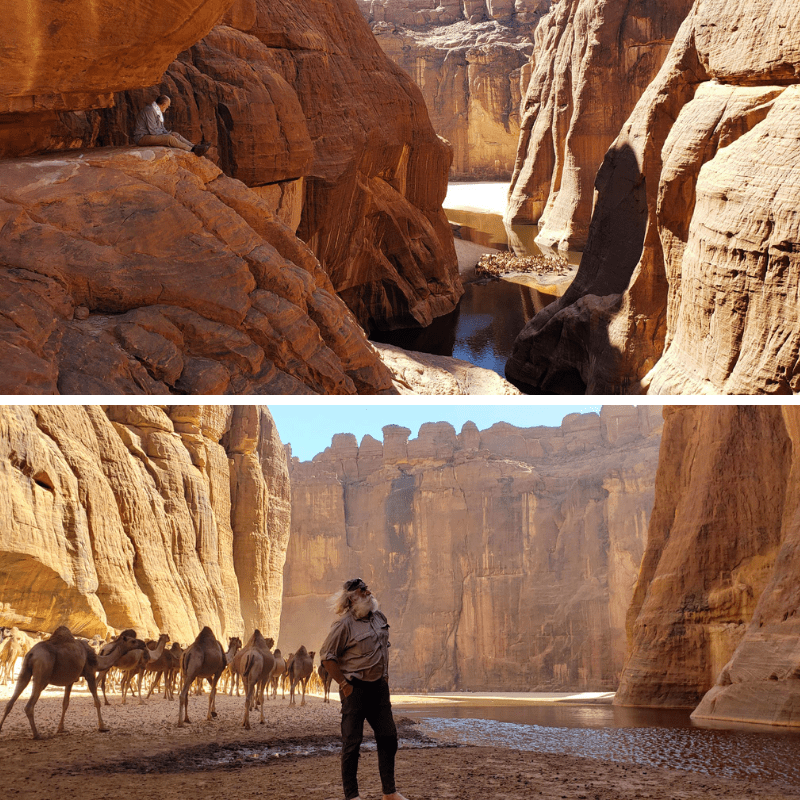
Back in camp we are met by the African Parks team, who talk us through the tremendous challenges they face to preserve this incredible area, its wildlife, ancient cultures, and the 7,000-year-old rock art sites which give us a real glimpse into the nomadic lifestyles of the people of old.
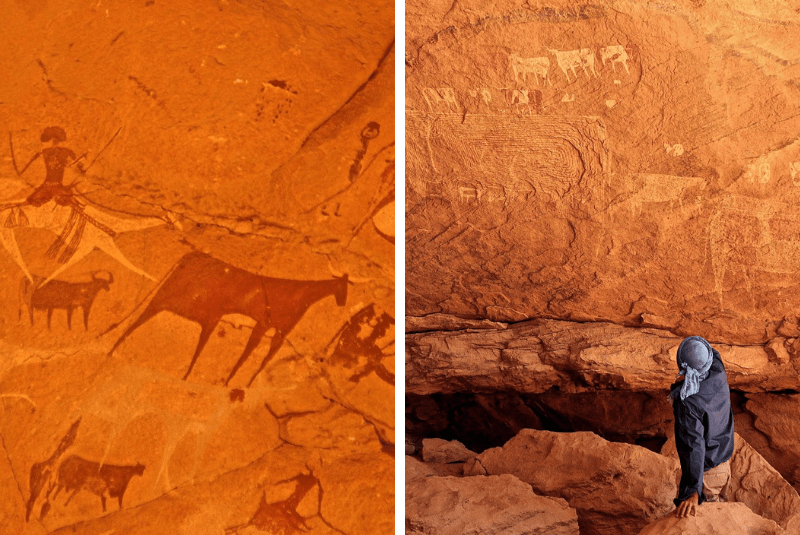
We are so privileged to be getting these incredible looks at ancient culture and the hard desert life of present day, as donkeys and camels pull buckets out of the Ketchebi Well.
Today we pack our bags for our fly-camping expedition of over 850 kilometers (528 miles) through the desert. And so, we race over the Sahara sand dunes on our Ennedi traverse. Our first camp is moonlit by the most illuminating full moon that I have ever seen. This site is called Achwili, recently discovered by our intrepid ground team. It nestles amongst the hundreds of incredibly weathered Tassili shapes that grow out of the yellow-brown Sahara sand—shapes that turned gold at sunset.
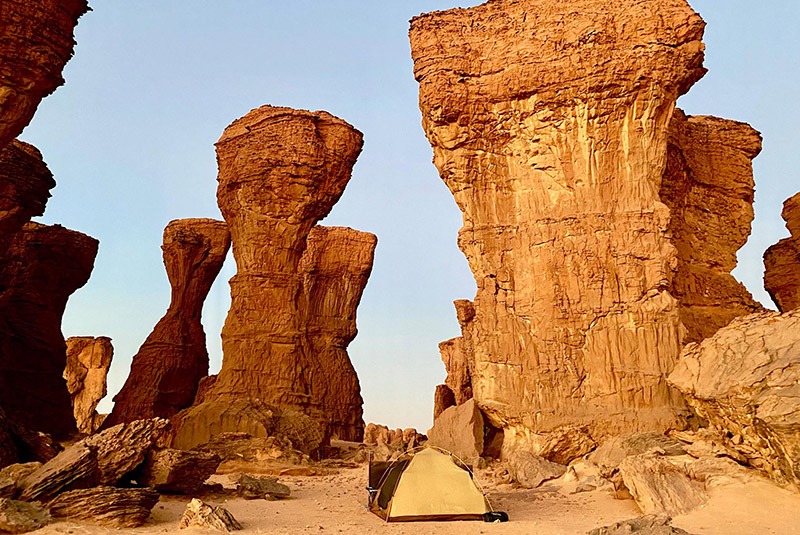
The next morning, we get our daily “keep the doctor away” fix of rock art and old nomadic village sites, marked by enough grinding stones to fill many a woven granary and pot shards from another era that are all around us. This is history on a grand scale!
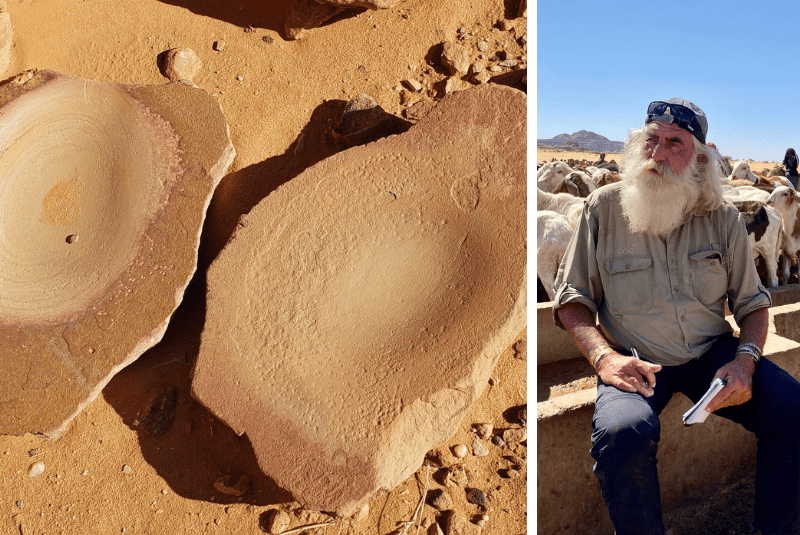
It’s different every day: red dunes, white dunes, yellow dunes, rocks in dunes, rolling giant dunes, barkhan dunes, oases, Star Wars set scenery, lakes, YES lakes—swimming in the Sahara!
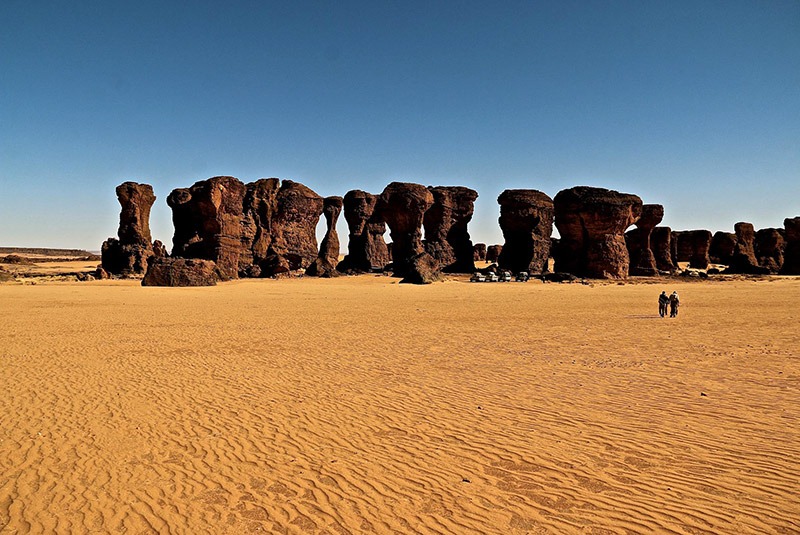
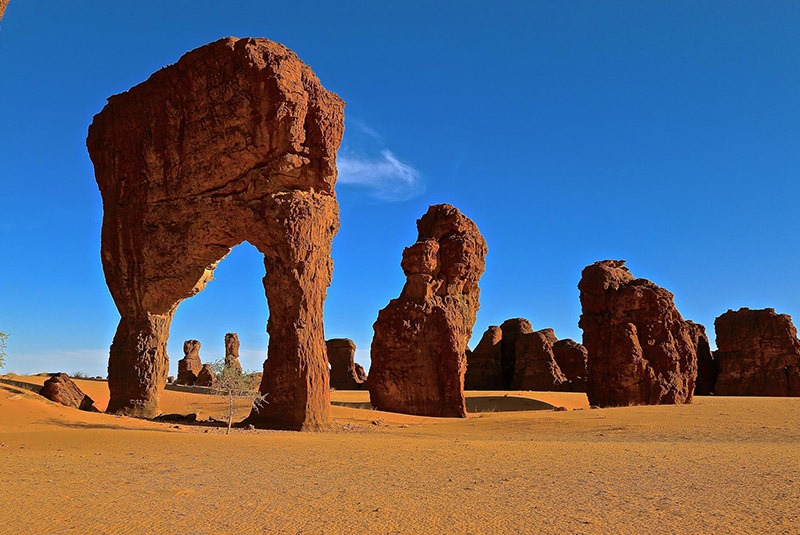
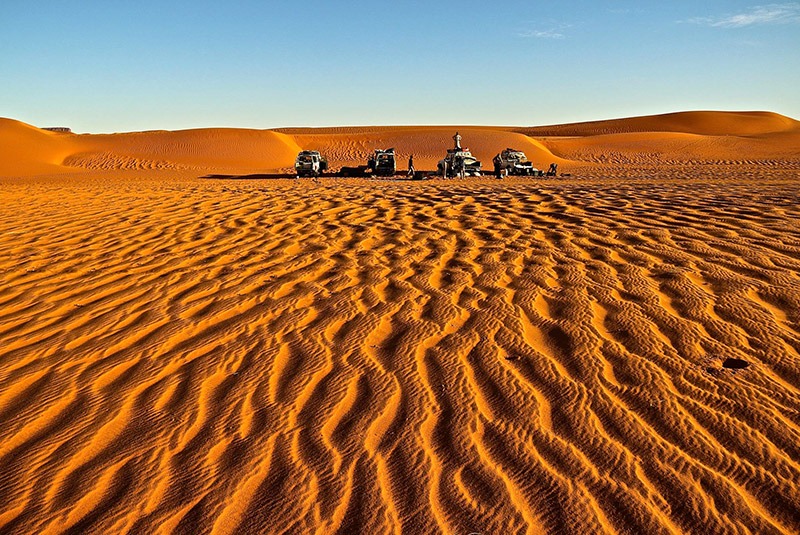
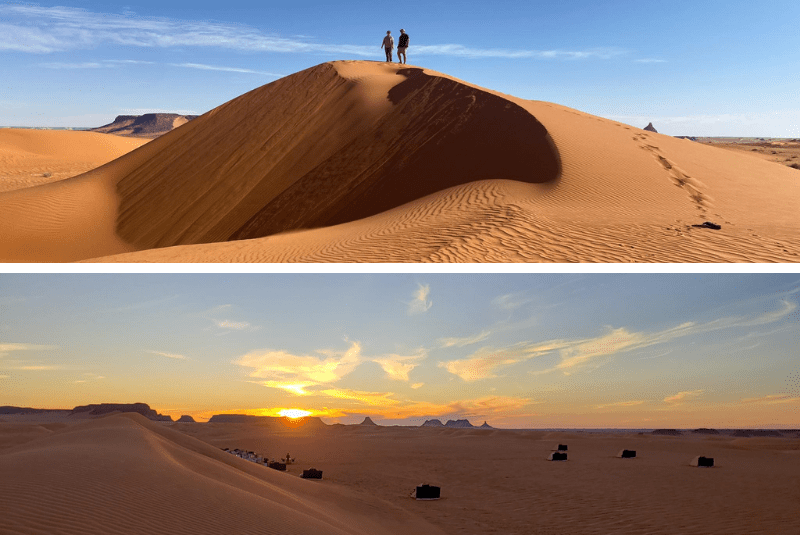
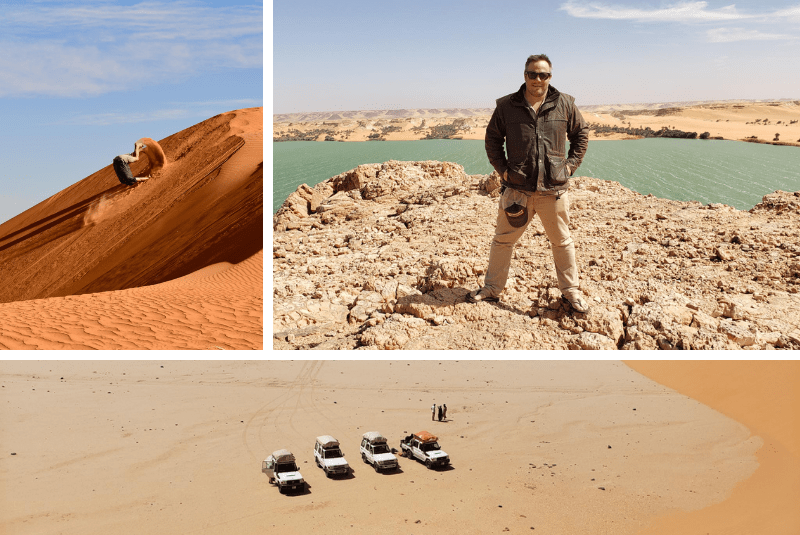
Warda camp makes the Sahara easy, but fly camping comes with challenges; these are far outweighed by the rewards, but they are challenges, nonetheless. The loo with a view is not a simple affair in the desert, but we do our best to find a place with enough cover. We will travel with a portable seat going forward; however, it was left behind on this trip, which created some complications.
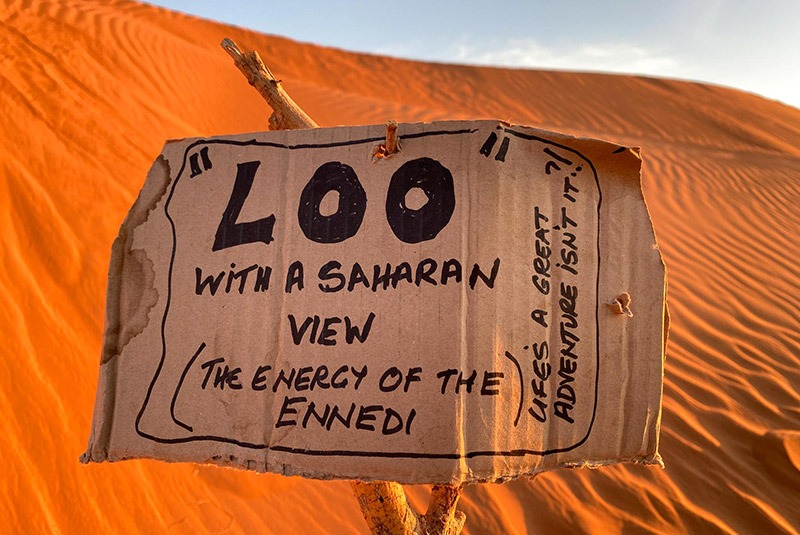
While finding a suitable site to relieve oneself was a challenge for the guests, a challenge for Kingsley and I was finding fire wood in a desert, so when you combine those two missions at the same time, it’s very important that paths don’t cross! Another hardship in the desert, and I must say this one took me by surprise: throughout our days here, I have been more cold than hot, even during the day!
As our traverse through the great Ennedi Massif continues, we enter a small town near the border of Libya and see the massive, overloaded trucks bringing fuel into the country. It’s our chance to stock up on basic food supplies and fuel while getting a fly-on-the-wall view of a typical Saharan town. It’s goat meat, market supplies, and fuel from a drum across from the old, crumbling mud-built French colonial fort, so proudly displaying the Chadian colors of red, blue, and yellow at its entrance. During colonial times, the fort was manned by French and Senegalese soldiers. Sadly, pictures were prohibited so you’ll have to settle for a picture of Kingsley and I enjoying a little market goat.
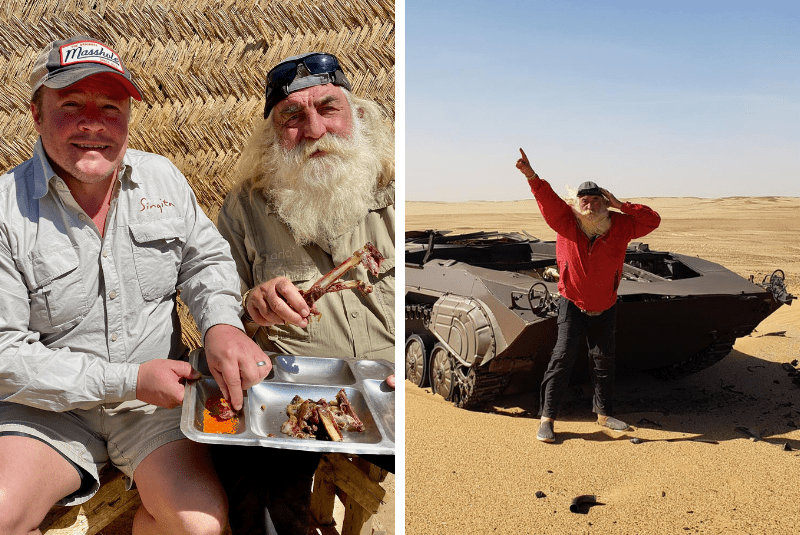
After restocking and some great interaction in the local market, we are once again racing through the desert. We pass a graveyard of Gaddafi’s tanks, the futile battle against the “Terror of the Tubu,” and then it’s lunch at yet another rock art site.
Our tires sing across the soft Saharan sand, racing against the sun, reaching Bichagara for the forever views over the world’s largest desert and the freedom of it all. This is what we came for and Kingsley and I are hugely grateful to GeoEx for their masterful work in piecing this trip together, and of course our wonderful travel companions who ultimately make an adventure like this possible. I remember saying to Kingsley as we sat around a circle of stones lit by the flames of a windswept fire, “We have had some epic adventures together but this one is right up there; this is one of the greatest adventures of my life.”
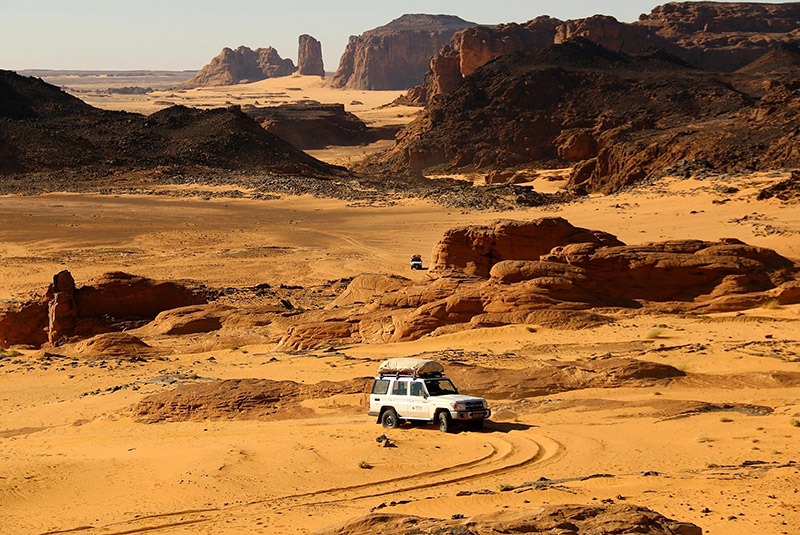
Next morning, Kingsley reads through and quotes the notes from Wilfred Thesinger’s book, The Life of My Choice, describing the time when he visited the Ennedi in 1938. He wrote, “Beyond the Wadi Hauash, we followed the western edge of the Ennedi Massif where a series of plateaus, weathered peaks and pinnacles rise 5,000 feet and were intercepted by sheer-sided gorges. In their rock faces were many caves, in some of which I found paintings in different colors, depicting hunting scenes, horsemen, camels, long-horned cattle, and human figures clothed and naked . . . the Badayat said there were many such paintings in the heart of the Ennedi . . .” That was 83 years ago and still today, only a fortunate few get to visit and experience the magic of the Ennedi, a once-in-a-lifetime journey across the Sahara.
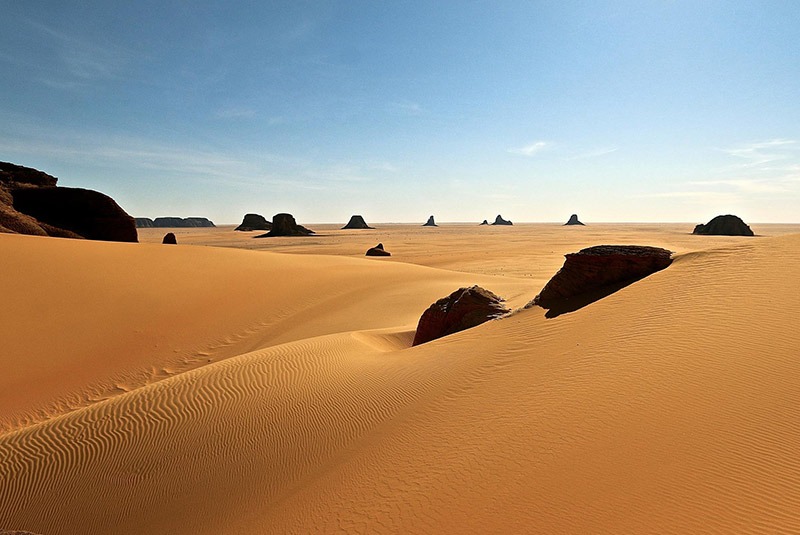
With great thanks to Kingsley Holgate who helped me write this—he is actually not the worst writer, so when the writing became smooth, clear, powerful, interesting, and eloquent, then you know who to credit! Thanks to Charlie Eilers and Alicia Moorehead for kindly letting me use some of their pictures in this post. Thanks for reading and hope to see you somewhere wild!
Lastly, to African Parks and our team in the Ennedi lead by Pier Paulo, thank you for your passion and dedication that allows the likes of us to experience the fruits of your work. We will keep coming because we know if it doesn’t pay, it doesn’t stay! GeoEx team, please give yourself a pat on the back for an absolute masterclass!
* * * * *
To learn more about our small group adventures with Brad Hansen and Kingsley Holgate in Chad and other astonishing destinations in Africa, call our travel experts at 888-570-7108.

